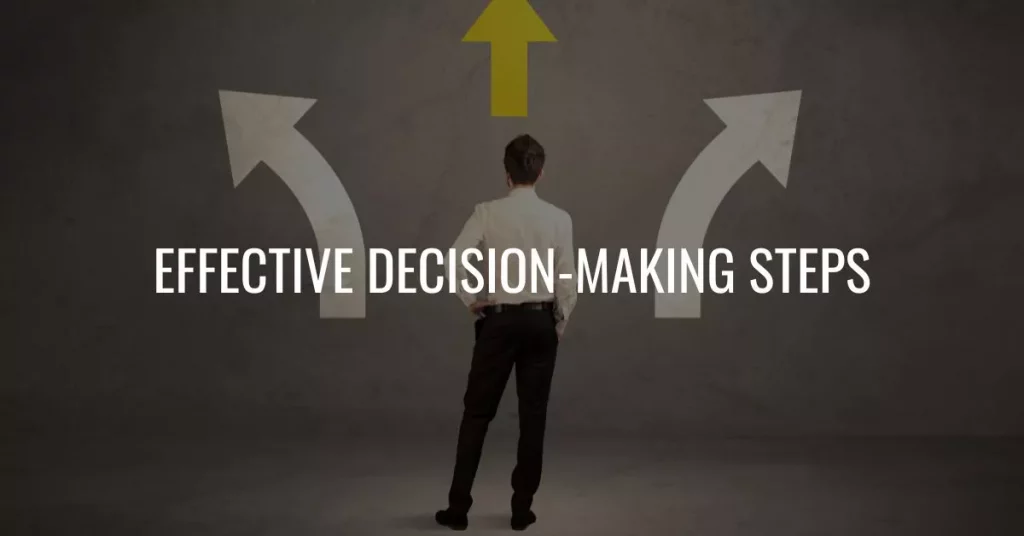Effective Decision Making Steps!
Decisions are made constantly at every level in the organization. Decision making includes strategic decisions, managerial decisions, routine operational decisions, and even personal decisions.
So any person makes decisions but only good people make effective decisions that make a difference.
Many people find it hard to make effective decisions, but unfortunately, we all have to take decisions even when we decide not to take a decision, it’s a decision and has its impacts. So you should know how to take and make an effective decision in the right way.

Effective decision making definition:
Decision making: is selecting choices or compromises from the available options in order to meet your goals or organization’s goals.
Effective decision making: it’s about the process through which choices are selected from the available options and then managed through implementation to achieve your goals or the organization’s goal.
Effective decision making importance:
As the manager, your decisions are very important because by a decision you can add value to your products, develop your team skills, increase the performance of the employees or increase the outcomes, in other words your decisions are the key to your success. So your decision is important to:
- Face the problems and challenges
- Motivate your employees
- Inspiring your people
- Increase the efficiency
- Handle the resources
- Grow up your business
In this article we are talking about the decisions when you have enough time to decide which action you will take will be better than others, but sometimes you don’t have enough time to know which action is best and you have to make a decision fast; in cases like that you should make a decision while you are keeping an eye on your goals then let your intuition suggest you the right choice.
Effective decision making steps:
So how to make the right choice!! here are some decision making skills
Step 1: Identify the decision:
The first step to making a decision is to realize that you need to make a decision and:
- identify and understand the nature of the decision you should take
- identify what the factors are considered in making the decision
- Identify the current situation and the desired situation.
A useful way to identify the decision is by thinking about the following questions:
- Do you think there is an issue that needs a decision?
- What is the current situation?
- When, where, and why does the issue appear?
- Who is involved in the issue?
Example: assume that you are a manager in the HR department in an organization, so you should know that one of your responsibilities is handling the human resources and hiring new people, and you should know how your organization is growing up, what the needed resources are, when and where you will hire new people and who are involved in hiring new people.
Step 2: Gather the relevant information:
To make the right decision you should first collect all information about the decision. Gathering information helps you to make effective decisions and:
- Strengthen the situation identification and awareness of how serious the situation is.
- Knowing the size of the gap between your vision and the current situation.
- Boost your Self-confidence because by the gathered information you know the current situation and know what you should do.
Example: in the previous example; you should gather all data about the employees and their job descriptions:
- How many are the current employees? Do they do all the required work or do you need to hire new people?
- How many people do you need to hire? Can you make a job rotation to overcome the resources issue? And how can you do that?
- What are the problems that will occur if you didn’t hire new people?
Step 3: Identify and evaluate the alternatives:
After identifying the decision and gathering the relevant information then identify the alternative options and write down the possible negative and positive outcomes for each alternative option to make your effective decision.
You can determine the alternatives by Imagination, making research, having discussions with your team, or asking people who have more experience. The following questions will help you to identify and evaluate the possible alternatives:
- What are the possible decisions?
- What are the negatives and positives of each option?
- What if the decision is delayed?
- What if the situation remains as it is?
Keep in mind delaying the decision is an alternative option and also remaining the current situation as it is, is a decision.
Example: in our example, there are 4 options: you can fill down the following table to identify and evaluate the alternatives, and rate each alternative from (0 To 10)
| Options | Evaluating each decision |
|---|---|
| Hiring new people | 6 |
| Making job rotation | 8 |
| Delaying the decision | 4 |
| Remaining the current situation is | 3 |
| Additional options | 4 |
Then apply the decision which has the highest rate.
Step 4: Choose among the alternatives and take your decision:
Once you have identified and evaluated all possible alternatives, you are ready to select the alternative that seems to be the best for you, your team, and your company.
You may choose a combination of alternatives based on the evaluation. Such as you may hire some people with job rotation to overcome the resources issue or may your decision is to hire new people after a particular time and so on.
Step 5: Execute your decision:
For effective decision making you should put your decision into action:
- Set a plan for implementing your decision, the plan should be cleared with specific steps and limited time to be effective.
- Then execute your decision according to your plan.
- Check continually the implementation to meet your goals. And if there is any unwanted deviation quickly adjust the plan to meet your goals.
Step 6: Evaluate the outcomes of your decision and action steps:
Evaluating the decision is a very important step for effective decision making, so the good manager should follow up on his decision and know that the decision doesn’t end at taking, but should be implemented and developed.
- The good manager always evaluates his/her decision during and after implementation, and if there is any mistake he/she tries to correct it, maybe by modifying or even by changing the decision.
- Also to develop your decision-making skills, you should write down the learned lessons after implementing any decision.

Patrick is a lifelong learner and personal development blogger whose work focuses on mindset shifts, emotional growth, and the hard-won lessons from real-life challenges.
Qualities: Relatable, honest, introspective, growth-oriented.
